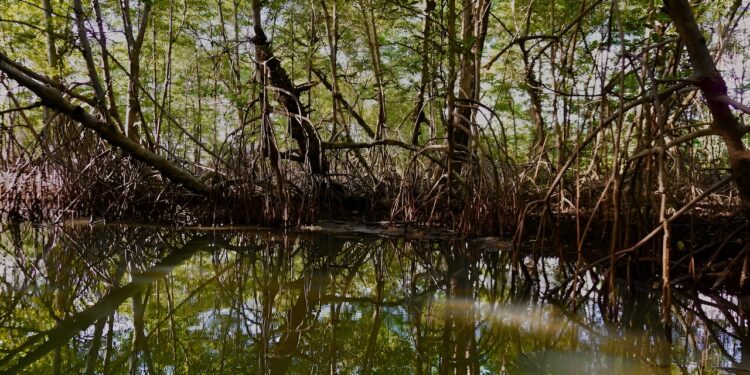Mangroves in Panama. Credit: Unsplash/CC0 Public domain
A team of environmental and natural scientists from EAFIT University in Colombia, the Smithsonian Tropical Research Institute in Panama and Boise State University in the United States have found evidence of an ancient petrified mangrove forest on a Panama Canal Island. For their study, reported in the journal Paleogeography, Paleoclimatology, Paleoecologythe group collected fossils and sediment samples from the island.
Previous research has shown that about 23 million years ago, the South American and Caribbean plates collided, pushing up parts of what is now Central America. One area became a large hill, forming what is now known as Barro Colorado Island. It is located in Gatun Lake, which is part of the Panama Canal.
In this new effort, the research team studied 121 preserved pieces of wood found on the island over the past several years. They also studied sediment samples collected from the sites where the fossils were found. They determined that many of the fossils came from a type of mangrove that no longer exists.
Dating the fossils showed them to be around 22 million years old. Additionally, the sediment came from a lahar, a type of river of mud and rock, similar in many ways to concrete, that forms when water rushes down a mountain after a volcanic eruption.
Researchers suggest that about 1 million years after Barro Colorado Island formed, a volcano erupted, followed by a lahar, which covered the island in mud and rock. It also covered the mangrove forest that had grown around the island. And because the lahar must have contained water rich in silica, which promotes petrification, and because of the high rate at which the trees were covered, the perimeter of the island became a petrified forest, most of which is still buried.
The research team named the new tree species Sonneratioxylon barrocoloradoensis. They suspect that due to higher levels of carbon dioxide in the air at the time of its existence, it was probably larger than modern mango trees.
More information:
Camila Martínez et al, An early Miocene (Aquitanian) fossil mangrove forest buried by a volcanic lahar on Barro Colorado Island, Panama, Paleogeography, Paleoclimatology, Paleoecology (2023). DOI: 10.1016/j.palaeo.2023.112006
© 2024 Science X Network
Quote: 22-million-year-old petrified mangrove forest found in the Panama Canal (January 11, 2024) retrieved January 11, 2024 from
This document is subject to copyright. Apart from fair use for private study or research purposes, no part may be reproduced without written permission. The content is provided for information only.



